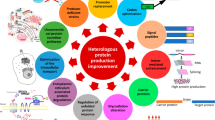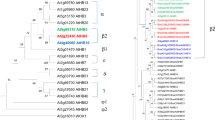Abstract
Fusarium oxysporum produces three kinds of asexual spores, macroconidia, microconidia, and chlamydospores. We previously identified two genes, REN1 and FoSTUA, which encode different types of transcription regulators essential for conidiation in F. oxysporum. We also performed expressed sequence tag analysis during vegetative growth and conidiation and identified 496 genes specifically detected in the conidiation cDNA library. Here, we selected genes with expression levels affected by a mutation in REN1 or FoSTUA in F. oxysporum. The transcription levels of 496 conidiation library-specific genes were compared between the wild-type strain and the ΔREN1 mutant or the ΔFoSTUA mutant by cDNA dot–blot differential hybridization and real-time quantitative PCR analyses. We found 23 and 12 genes, which had transcription levels more than tenfold lower and higher, respectively, in the ΔREN1 mutant than in the wild type. This result suggested that the 23 were positively and 12 genes negatively regulated by Ren1. We also found three genes positively regulated by FoStuA: the transcription levels of these genes were more than tenfold lower in the ΔFoSTUA mutant. The Ren1-regulated genes included genes that were also upregulated specifically under conidiation conditions in the wild-type strain. These genes provide candidates for further studies directed at understanding fungal conidiogenesis and its molecular regulation.



Similar content being viewed by others
References
Adams TH, Boylan MT, Timberlake WE (1988) brlA is necessary and sufficient to direct conidiophore development in Aspergillus nidulans. Cell 54:353–362
Adams TH, Wieser JK, Yu JH (1998) Asexual sporulation in Aspergillus nidulans. Microbiol Mol Biol Rev 62:35–54
Altschul SF, Madden TL, Schäfer AA, Zhang J, Zhang Z, Miller W, Lipman DJ (1997) Gapped BLAST and PSI-BLAST: a new generation of protein database search programs. Nucleic Acids Res 25:3389–3402
Andrianopoulos A, Timberlake WE (1994) The Aspergillus nidulans abaA gene encodes a transcriptional activator that acts as a genetic switch to control development. Mol Cell Biol 14:2503–2515
Armstrong GM, Armstrong JK (1981) Formae speciales and races of Fusarium oxysporum causing wilt diseases. In: Nelson PE, Toussoum TA, Cook RJ (eds) Fusarium: diseases, biology and taxonomy. Pennsylvania State University Press, University Park, PA, pp 391–399
Arst HN, Peñalva MA (2003) pH regulation in Aspergillus and parallels with higher eukaryotic regulatory systems. Trends Genet 19:224–231
August PR, Tang L, Yoon YJ, Ning S, Mueller R, Yu TW, Taylor M, Hoffmann D, Kim CG, Zhang X, Hutchinson CR, Floss HG (1998) Biosynthesis of the ansamycin antibiotic rifamycin: deductions from the molecular analysis of the rif biosynthetic gene cluster of Amycolatopsis mediterranei S699. Chem Biol 5:69–79
Beckman CH (1987) The nature of wilt diseases of plants. American Phytopathological Society Press, St Paul, MN
Borghouts C, Scheckhuber CQ, Stephan O, Osiewacz HD (2002) Copper homeostasis and aging in the fungal model system Podospora anserina: differential expression of PaCtr3 encoding a copper transporter. Int J Biochem Cell Biol 34:1355–1371
Boylan MT, Mirabito PM, Willet CE, Zimmerman CR, Timberlake WE (1987) Isolation and physical characterization of three essential conidiation genes from Aspergillus nidulans. Mol Cell Biol 7:3113–3118
Busby TM, Miller KY, Miller BL (1996) Suppression and enhancement of the Aspergillus nidulans medusa mutation by altered dosage of the bristle and stunted genes. Genetics 143:155–163
Cappellini RA, Peterson JL (1965) Macroconidium formation in submerged cultures by a nonsporulating strain of Gibberella zeae. Mycologia 57:962–966
Caracuel Z, Roncero MIG, Espeso EA, González-Verdejo CI, García-Maceira FI, Di Pietro A (2003) The pH signaling transcription factor PacC controls virulence in the plant pathogen Fusarium oxysporum. Mol Microbiol 48:765–779
Caracuel Z, Martinez-Rocha AL, Di Pietro A, Madrid MP, Roncero MIG (2005) Fusarium oxysporum gas1 encodes a putative beta-1,3-glucanosyltransferase required for virulence on tomato plants. Mol Plant Microbe Interact 18:1140–1147
Clutterbuck AJ (1969) A mutational analysis of conidial development in Aspergillus nidulans. Genetics 63:317–327
Couteaudier Y, Alabouvette C (1990) Survival and inoculum potential of conidia and chlamydospores of Fusarium oxysporum f. sp. lini in soil. Can J Microbiol 36:551–556
Dahlberg KR, Van Etten JL (1982) Physiology and biochemistry of fungal sporulation. Annu Rev Phytopathol 20:281–301
Dilcher M, Köhler B, von Mollard GF (2001) Genetic interactions with the yeast Q-SNARE VTI1 reveal novel functions for the R-SNARE YKT6. J Biol Chem 276:34537–34544
Dutton JR, Johns S, Miller BL (1997) StuAp is a sequence-specific transcription factor that regulates developmental complexity in Aspergillus nidulans. EMBO J 16:5710–5721
Eisendle M, Oberegger H, Zadra I, Haas H (2003) The siderophore system is essential for viability of Aspergillus nidulans: functional analysis of two genes encoding l-ornithine N 5-monooxygenase (sidA) and a non-ribosomal peptide synthetase (sidC). Mol Microbiol 49:359–375
Etienne-Manneville S, Hall A (2002) Rho GTPases in cell biology. Nature 420:629–635
Exley GE, Colandene JD, Garrett RH (1993) Molecular cloning, characterization, and nucleotide sequence of nit-6, the structural gene for nitrite reductase in Neurospora crassa. J Bacteriol 175:2379–2392
Gems DH, Clutterbuck AJ (1994) Enhancers of conidiation mutants in Aspergillus nidulans. Genetics 137:79–85
Guest GM, Lin X, Momany M (2004) Aspergillus nidulans RhoA is involved in polar growth, branching, and cell wall synthesis. Fungal Genet Biol 41:13–22
Haas H, Schoeser M, Lesuisse E, Ernst JF, Parson W, Abt B, Winkelmann G, Oberegger H (2003) Characterization of the Aspergillus nidulans transporters for the siderophores enterobactin and triacetylfusarinine C. Biochem J 371:505–513
Iida Y, Ohara T, Tsuge T (2006) Identification of genes up-regulated during conidiation of Fusarium oxysporum through expressed sequence tag analysis. Fungal Genet Biol 43:179–189
Kachroo P, Leong SA, Chatto BB (1994) Pot2, an inverted repeat transposon from the rice blast fungus Magnaporthe grisea. Mol Gen Genet 245:339–348
Katan T, Shlevin E, Katan J (1997) Sporulation of Fusarium oxysporum f. sp. lycopersici on stem surfaces of tomato plants and aerial dissemination of inoculum. Phytopathology 87:712–719
Lau GW, Hamer JE (1998) Acropetal: a genetic locus required for conidiophore architecture and pathogenicity in the rice blast fungus. Fungal Genet Biol 24:228–239
Levis C, Fortini D, Brygoo Y (1997) Flipper, a mobile Fot1-like transposable element in Botrytis cinerea. Mol Gen Genet 254:674–680
Madaule P, Axel R, Myers AM (1987) Characterization of two members of the rho gene family from the yeast Saccharomyces cerevisiae. Proc Natl Acad Sci USA 84:779–783
Marzluf GA (1997) Genetic regulation of nitrogen metabolism in the fungi. Microbiol Mol Biol Rev 61:17–32
Matzanke BF, Bill E, Trautwein AX, Winkelmann G. 1987. Role of siderophores in iron storage in spores of Neurospora crassa and Aspergillus ochraceus. J Bacteriol 169:5873–5876
Mewes HW, Frishman D, Güldener U, Mannhaupt G, Mayer K, Mokrejs M, Morgenstern B, Münsterkötter M, Rudd S, Weil B (2002) MIPS: a database for genomes and protein sequences. Nucleic Acids Res 30:31–34
Michán S, Lledías F, Hansberg W (2003) Asexual development is increased in Neurospora crassa cat-3-null mutant strains. Eukaryot Cell 2:798–808
Miller KY, Wu J, Miller BL (1992) StuA is required for cell pattern formation in Aspergillus. Genes Dev 6:1770–1782
Mirabito PM, Adams TH, Timberlake WE (1989) Interactions of three sequentially expressed genes control temporal and spatial specificity in Aspergillus development. Cell 57:859–868
Namiki F, Shiomi T, Kayamura T, Tsuge T (1994) Characterization of the formae speciales of Fusarium oxysporum causing wilts of cucurbits by DNA fingerprinting with nuclear repetitive DNA sequences. Appl Environ Microbiol 60:2684–2691
Nelson PE (1981) Life cycle and epidemiology of Fusarium oxysporum. In: Mace ME, Bell AA, Beckman CH (eds) Fungal wilt diseases of plants. Academic, New York, pp 51–80
Nelson PE, Toussoun TA, Marasas WFO (1983) Fusarium species: an illustrated manual for identification. Pennsylvania State University Press, University Park, PA
Nelson KE, Weinel C, Paulsen IT, Dodson RJ, Hilbert H, Martins dos Santos VAP, Fouts DE, Gill SR, Pop M, Holmes M, Brinkac L, Beanan M, DeBoy RT, Daugherty S, Kolonay J, Madupu R, Nelson W, White O, Peterson J, Khouri H, Hance I, Chris Lee P, Holtzapple E, Scanlan D, Tran K, Moazzez A, Utterback T, Rizzo M, Lee K, Kosack D, Moestl D, Wedler H, Lauber J, Stjepandic D, Hoheisel J, Straetz M, Heim S, Kiewitz C, Eisen J, Timmis KN, Düsterhöft A, Tümmler B, Fraser CM (2002) Complete genome sequence and comparative analysis of the metabolically versatile Pseudomonas putida KT2440. Environ Microbiol 4:799–808
Ohara T, Tsuge T (2004) FoSTUA, encoding a basic helix-loop-helix protein, differentially regulates development of three kinds of asexual spores, macroconidia, microconidia, and chlamydospores, in the fungal plant pathogen Fusarium oxysporum. Eukaryot Cell 3:1412–1422
Ohara T, Inoue I, Namiki F, Kunoh H, Tsuge T (2004) REN1 is required for development of microconidia and macroconidia, but not of chlamydospores, in the plant pathogenic fungus Fusarium oxysporum. Genetics 166:113–124
Okuda M, Ikeda K, Namiki F, Nishi K, Tsuge T (1998) Tfo1: an Ac-like transposon from the plant pathogenic fungus Fusarium oxysporum. Mol Gen Genet 258:599–607
Peplow AW, Tag AG, Garifullina GF, Beremand MN (2003) Identification of new genes positively regulated by Tri10 and a regulatory network for trichothecene mycotoxin production. Appl Environ Microbiol 69:2731–2736
Perry JR, Basrai MA, Steiner HY, Naider F, Becker JM (1994) Isolation and characterization of a Saccharomyces cerevisiae peptide transport gene. Mol Cell Biol 14:104–115
Rekah Y, Shtienberg D, Katan J (2000) Disease development following infection of tomato and basil foliage by airborne conidia of the soilborne pathogens Fusarium oxysporum f. sp. radicis-lycopersici and F. oxysporum f. sp. basilici. Phytopathology 90:1322–1329
Rowe RC, Farley JD, Coplin DC (1977) Airborne spore dispersal and recolonization of steamed soil by Fusarium oxysporum in tomato greenhouses. Phytopathology 67:1513–1517
Springer ML (1993) Genetic control of fungal differentiation: the three sporulation pathways of Neurospora crassa. BioEssays 15:365–374
Tilburn J, Sarkar S, Widdick DA, Espeso EA, Orejas M, Mungroo J, Peñalva MA, Arst HN Jr (1995) The Aspergillus PacC zinc finger transcription factor mediates regulation of both acid- and alkaline-expressed genes by ambient pH. EMBO J 14:779–790
Tsukagoshi N, Kobayashi T, Kato M (2001) Regulation of the amylolytic and (hemi-)cellulolytic genes in aspergilli. J Gen Appl Microbiol 47:1–19
Ward TJ, Bielawski JP, Kistler HC, Sullivan E, O’Donnell K (2002) Ancestral polymorphism and adaptive evolution in the trichothecene mycotoxin gene cluster of phytopathogenic Fusarium. Proc Natl Acad Sci USA 99:9278–9283
Weierstall T, Hollenberg CP, Boles E (1999) Cloning and characterization of three genes (SUT1–3) encoding glucose transporters of the yeast Pichia stipitis. Mol Microbiol 31:871–883
Acknowledgments
We are grateful to Fumio Namiki, Hirofumi Yoshioka, Kazuhito Kawakita, and Noriyuki Doke for valuable suggestions; the Radioisotope Research Center, Nagoya University, for technical assistance. This work was supported by grants-in-aids from Japanese Society for Promotion of Sciences (Nos. 14656017, 15208005, and 16658019) (T.T.) and a Research Fellowship of Japan Society for the Promotion of Science for Young Scientists (Y.I.).
Author information
Authors and Affiliations
Corresponding author
Rights and permissions
About this article
Cite this article
Iida, Y., Ohara, T. & Tsuge, T. Identification of genes with changes in transcription levels caused by mutations in conidiation regulator genes REN1 and FoSTUA in Fusarium oxysporum . J Gen Plant Pathol 73, 158–167 (2007). https://doi.org/10.1007/s10327-007-0002-3
Received:
Accepted:
Published:
Issue Date:
DOI: https://doi.org/10.1007/s10327-007-0002-3




